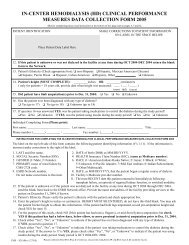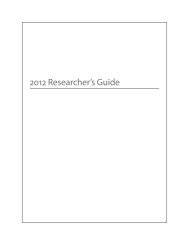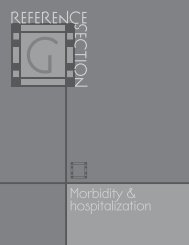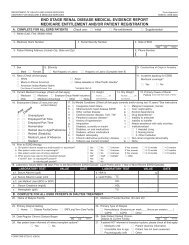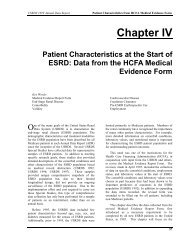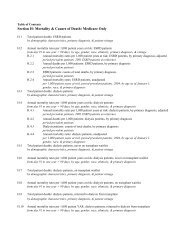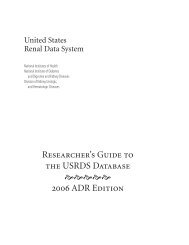2009 ADR v2 Atlas of ESRD - United States Renal Data System
2009 ADR v2 Atlas of ESRD - United States Renal Data System
2009 ADR v2 Atlas of ESRD - United States Renal Data System
Create successful ePaper yourself
Turn your PDF publications into a flip-book with our unique Google optimized e-Paper software.
5<br />
glossary<br />
pg 394<br />
Acute kidney injury (AKI) Also<br />
known as acute kidney failure or<br />
acute renal failure is a sudden<br />
decline in renal function triggered<br />
by a number <strong>of</strong> acute<br />
occurrances such as shock,<br />
trauma, drug toxicity, or kidney<br />
stones.<br />
Acute myocardial infarction (AMI) An<br />
event causing injury to the heart<br />
muscle.<br />
Adult polycystic kidney disease An inherited<br />
disease in which the kidneys contain<br />
multiple cysts.<br />
Anemia A condition marked by a reduced<br />
number <strong>of</strong> red cells in the<br />
bloodstream.<br />
Angiography A radiographic procedure<br />
where a radio-opaque contrast material<br />
is injected into a blood vessel for<br />
the purpose <strong>of</strong> identifying its anatomy.<br />
Angioplasty A procedure in which a balloon<br />
catheter is inserted into a blocked<br />
or narrowed vessel in order to reopen<br />
the vessel and allow normal blood fl ow.<br />
Angiotensin converting enzyme (ACE) inhibitor<br />
An antihypertensive agent that inhibits<br />
the production <strong>of</strong> angiotensin<br />
II. Can delay progression to diabetes<br />
or kidney disease.<br />
Angiotensin II receptor blocker (ARB) an antihypertensive<br />
agent that inhibits the<br />
actions <strong>of</strong> angiotensin II, a substance<br />
which causes narrowing <strong>of</strong> blood vessels.<br />
Arteriovenous fi stula A type <strong>of</strong> vascular<br />
access used in hemodialysis patients,<br />
and created by the anastomosis <strong>of</strong> the<br />
radial artery and the cephalic vein.<br />
Arteriovenous graft A type <strong>of</strong> vascular access<br />
used in hemodialysis patients and<br />
created via a connection between an<br />
artery and vein using either a native<br />
vessel (saphenous vein) or a synthetic<br />
material such as Tefl on.<br />
Atherosclerotic heart disease (ASHD) A disease<br />
<strong>of</strong> the arteries <strong>of</strong> the heart, characterized<br />
by a thickening and/or loss<br />
<strong>of</strong> elasticity <strong>of</strong> the arterial walls.<br />
Beta blockers Antihypertensive medications<br />
that block production <strong>of</strong> nor-<br />
epinephrine, slowing the heart rate<br />
and preventing the constriction <strong>of</strong><br />
blood vessels.<br />
Blood urea nitrogen (BUN) A by-product<br />
<strong>of</strong> the breakdown <strong>of</strong> amino acids and<br />
endogenous and ingested protein.<br />
Body mass index (BMI) A measure <strong>of</strong><br />
height to weight ratio: weight (kg)/<br />
height (m 2 ).<br />
C-reactive protein A protein produced<br />
by the liver in response to infection or<br />
injury; high levels are associated with<br />
an increased risk <strong>of</strong> heart disease and<br />
stroke.<br />
Calcium channel blockers Antihypertensive<br />
agents that work by blocking the<br />
access <strong>of</strong> calcium to muscle cells in artery<br />
walls.<br />
Cardiac arrest A complete cessation <strong>of</strong><br />
cardiac activity.<br />
Cardiac resynchronization therapy defi brillator<br />
(CRT-D) A device designed to arrest<br />
the fi brillation <strong>of</strong> (heart muscle) by applying<br />
electric shock across the chest,<br />
thus depolarising the heart cells and allowing<br />
normal rhythm to return.<br />
Cardiomyopathy A general diagnostic<br />
term indicating a primary non-infl ammatory<br />
disease <strong>of</strong> the heart muscle.<br />
Catheter A vascular access used in hemodialysis<br />
patients, commonly implanted<br />
into the jugular or subclavian<br />
vein.<br />
Centers for Disease Control & Prevention<br />
(CDC) The lead federal agency for protecting<br />
the health and safety <strong>of</strong> people<br />
at home and abroad; develops and<br />
applies programs designed to improve<br />
the health <strong>of</strong> the people <strong>of</strong> the <strong>United</strong><br />
<strong>States</strong>.<br />
Centers for Medicare and Medicaid Services<br />
(CMS) Formerly the Health Care Financing<br />
Administration (HCFA). Federal<br />
agency that administers the Medicare,<br />
Medicaid, and State Childrens’ Health<br />
insurance programs.<br />
Cerebrovascular accident (CVA) A general<br />
descriptor that encompasses such<br />
problems as stroke and cerebral hemorrhage.<br />
Cerebrovascular disease A disease that<br />
causes narrowing or occlusion <strong>of</strong> the<br />
arteries supplying blood to the brain.<br />
Chain provider A single business entity<br />
that at years end owns or operates<br />
20 or more freestanding dialysis units.<br />
This defi nition applies to all chain affi liation<br />
references in the USRDS Annual<br />
<strong>Data</strong> Reports. An alternative defi nition<br />
from the Centers for Medicare and<br />
Medicaid Services can be found under<br />
“defi nitions” in the Health Care Provider/Supplier<br />
Application Form, CMS 855.<br />
Chronic kidney disease (CKD) A condition<br />
in which there is a progressive loss <strong>of</strong><br />
kidney function which over time may<br />
lead to end-stage renal disease.<br />
Chronic obstructive pulmonary disease (COPD)<br />
A progressive disease characterized<br />
by coughing, wheezing, or diffi culty<br />
in breathing.<br />
Clinical Performance Measures (CPM) Project<br />
Formerly the Core Indicator Project.<br />
A project in which CMS and the<br />
<strong>ESRD</strong> networks cooperatively maintain<br />
a clinical database <strong>of</strong> key elements<br />
related to the quality <strong>of</strong> dialysis care.<br />
These elements are used as indicators<br />
in quality improvement initiatives.<br />
Common Working File (CWF) <strong>System</strong> The<br />
Medicare inpatient/outpatient and<br />
physician/supplier benefit coordination<br />
and claims validation system.<br />
Under the CWF, CMS maintains both<br />
institutional and physician supplier<br />
claims-level data. CWF claims records<br />
are the data source for most claims<br />
and utilization fi les used by the USRDS.<br />
Comprehensive Dialysis Study (CDS) A special<br />
data collection study that focuses<br />
on physical activity level, health-related<br />
quality <strong>of</strong> life, and work/disability<br />
status reported by patients who have<br />
recently started maintenance dialysis.<br />
Congestive heart failure (CHF) A condition<br />
caused by ineff ective pumping <strong>of</strong> the<br />
heart and subsequent fl uid accumulation<br />
in the lungs.<br />
Continuous ambulatory peritoneal dialysis<br />
(CAPD) A type <strong>of</strong> dialysis in which dialysate<br />
is continuously present in the abdominal<br />
cavity. Fluid is exchanged by<br />
using gravity to fi ll and empty the cavity<br />
4–5 -times each day.<br />
Continuous cycler-assisted peritoneal dialysis<br />
(CCPD) A type <strong>of</strong> dialysis in which the<br />
abdominal cavity is fi lled and emptied<br />
<strong>of</strong> dialysate using an automated cycler<br />
machine.<br />
Creatinine A waste product <strong>of</strong> protein<br />
metabolism found in the urine; <strong>of</strong>ten<br />
used to evaluate kidney function.<br />
Abnormally high creatinine levels indicate<br />
kidney failure or renal insuffi -<br />
ciency.<br />
Creatinine clearance Used as an indicator<br />
to predict the onset <strong>of</strong> uremia, which<br />
develops when creatinine clearance<br />
falls below 10 ml/minute/1.73 m 2 .<br />
Darbepoetin alfa (DPO) One <strong>of</strong> a class <strong>of</strong><br />
medications called erythropoietic proteins.<br />
Used to treat anemia in patient<br />
with serious kidney disease.<br />
Death Notifi cation Form (CMS-2746) A form<br />
submitted following the death <strong>of</strong> an<br />
<strong>ESRD</strong> patient, and containing basic patient<br />
demographic information in addition<br />
to information on the primary<br />
cause <strong>of</strong> death.<br />
Diabetes mellitus, insulin-dependent A condition<br />
in which insulin is necessary to<br />
regulate abnormally high levels <strong>of</strong> glucose<br />
(sugar) in the blood.<br />
Diagnosis Related Groups (DRGs) Used by<br />
Medicare to determine payment for inpatient<br />
hospital stays; based on diagnosis,<br />
age, gender, and complications.<br />
Employer group health plan (EGHP) A health<br />
plan <strong>of</strong> or contributed to by an employer,<br />
providing medical care directly or<br />
through other methods such as insurance<br />
or reimbursement to current or<br />
former employees, or to these employees<br />
and their families.<br />
End-stage renal disease (<strong>ESRD</strong>) A condition<br />
in which a person’s kidney function is<br />
inadequate to support life.<br />
Erythropoiesis stimulating agent (ESA)<br />
Used to increase the production <strong>of</strong><br />
red blood cells; includes erythropoietin<br />
(EPO) and darbepoetin alfa (DPO).<br />
Erythropoietin (EPO) A hormone secreted<br />
chiefl y by the adult kidney; acts on<br />
bone marrow to stimulate red cell production.<br />
Also produced in a formulated<br />
version to treat anemia.




